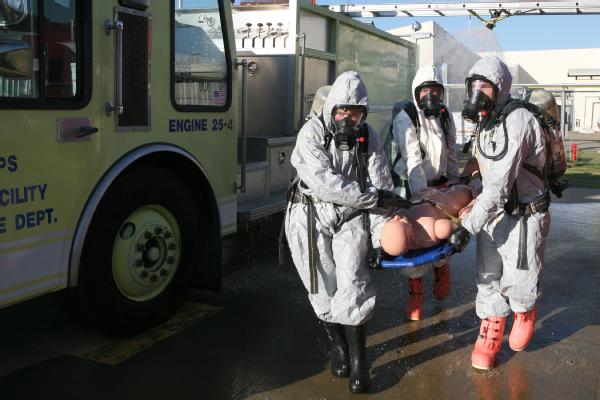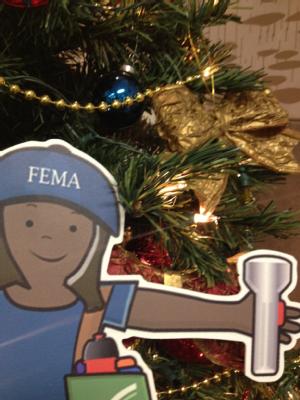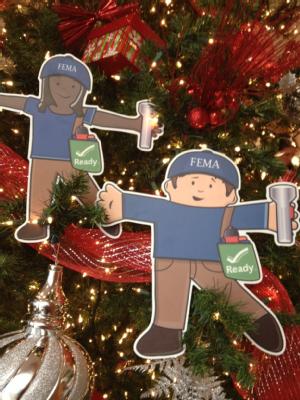Posted by: Mike Hall, Federal Coordinating Officer
It’s hard to believe I have been working alongside our disaster relief team in New Jersey for more than a month. Thirty-five days have passed since Hurricane Sandy first made landfall on the New Jersey coast on October 29
th. This marked one of the most damaging disasters in state history – battering the coastline with greater than 14-foot waves and wind gusts up to 88 mph. Even more unsettling were the 122,000 structures affected across 21 New Jersey counties – many of them damaged or destroyed. I’ve traveled to these hardest hit neighborhoods, met with the heartbroken of those who lost their homes, talked to children who were out of school, and committed to working with state and local officials to aid in the recovery efforts. As we move past this one month milestone, my primary focus remains on these people – the survivors of the storm.
When families and businesses begin to recover, whole communities begin to recover, and that is how New Jersey will revive and become stronger than ever. More than $730 million in federal disaster recovery money has been disbursed to start rebuilding the Garden State. Today we have more than 2,600 federal specialists working to support recovery in New Jersey, and our work is far from done.
State and federal disaster response teams were standing by with supplies even before Hurricane Sandy hit. As Sandy made its way up the east coast, FEMA and the Department of Defense established Incident Support Bases at Westover, Mass. and Lakehurst, New Jersey to position supplies and other resources close to areas in the hurricane’s path. Following the storm, more than 1.7 million meals and 2.6 million snacks have been served to survivors and first responders.
The New Jersey National Guard responded with a force of over 2,200 guardsmen. In addition, the Emergency Management Assistance Compact (EMAC) facilitated the deployment of 440 personnel and equipment from 12 states to support New Jersey. This included law enforcement teams who provided security and emergency medical services, partnering with us and other agencies to carry out critical life-saving and sustaining operations in the immediate aftermath. The National Weather Service was vital in predicting and tracking the storm, the U.S. Coast Guard for search and rescue, the U.S. Public Health Service to support shelter operations, and the U.S. Army Corps of Engineers for emergency generators, among others. Our operations to the response of the storm began aggressive and dynamic, and we will continue this same posture throughout the recovery process.
 CAPTION: Seaside Heights, N.J., Nov. 28, 2012 -- The American Flag raised by Seaside Heights resident in New Jersey.
CAPTION: Seaside Heights, N.J., Nov. 28, 2012 -- The American Flag raised by Seaside Heights resident in New Jersey.
It was clear one of the first steps was to support power restoration efforts to over 2.6 million homes, businesses and government customers. For this we needed the whole community to come together. The Department of Energy worked closely with the state Board of Public Utilities to bring together more than 23,000 utility professionals from New Jersey who, aided by companies across the country, worked to restore service across the state. The Department of Defense actually airlifted crews and vehicles to New Jersey from the west coast. The weather didn’t wait on our behalf to bring cold temperatures or wintry conditions to the region. A week after Sandy, the nor’easter deposited enough wet snow to break more trees, and down more power lines to delay cleanup efforts for another day. This meant that tens of thousands of residents were still waiting for their lights to come back on. By Nov. 14, electricity was restored to every home and business that was in condition to receive electrical power.
Access to fuel presented another challenge, and early on President Obama authorized the release of ultra-low sulfur diesel fuel from federal reserves to power government-owned and other vehicles being used in responding to the disaster. We set up six fueling stations for first responders accordingly.
One of the most heartwarming parts of disaster work is the opportunity to work with our voluntary agencies. These groups played a vital role in giving people needed shelter, a major lifeline for families displaced from their homes.
- At the peak 107 shelters were open with 4,370 people. Within three weeks, all shelters were able to close as displaced residents were assisted with finding lodging.
- By the time feeding sites were no longer needed, more than 1.7 million meals had been served, plus 2.6 million snacks.
- More than 31,000 cleanup kits had been issued and more than 23,000 comfort kits. Voluntary organizations served thousands of households doing clean-up and muck-outs and provided goods and services to hundreds of thousands of people – and pets - in need.
- These Organizations have clocked in over 600,000 recorded hours valued at $12.8 million dollars.
I extend my heartfelt thanks to them for their vital contributions to the Hurricane Sandy survivors.
 CAPTION: Ortley Beach, N.J., Nov. 28, 2012 -- Sharon Meyers, a Red Cross volunteer, offers a hot meal to a resident in Ortley Beach, NJ. The Red Cross is providing disaster relief, from hot meals to cleaning supplies and clothing to residents affected by Hurricane Sandy.
CAPTION: Ortley Beach, N.J., Nov. 28, 2012 -- Sharon Meyers, a Red Cross volunteer, offers a hot meal to a resident in Ortley Beach, NJ. The Red Cross is providing disaster relief, from hot meals to cleaning supplies and clothing to residents affected by Hurricane Sandy.
Alongside our partners we plan to tackle the housing issues to provide options for individuals and families. As survivors cope with the remains of their homes and belongings, we need to continue to help people find a safe place to stay. FEMA employed its Transitional Sheltering Assistance (TSA) program to allow nearly 3,000 individuals and families to lodge in 340 hotels during the first four-week period. We met this critical need in the short-term, but in the long-term I want folks back into their homes. Last week Gov. Christie approved New Jersey’s five-point long-range housing solution. It calls for the maximized use of existing rental properties; implementing our Sheltering and Temporary Essential Power program to render habitable dwellings that lack only minor fixes; using state and federally-owned real property; using FEMA Direct Housing Assistance in the form of HUD-certified manufactured housing; and rehabilitation of existing structures. Yet I know that these programs are only useful if people know about them.
FEMA’s Community Relations specialists and FEMA Corps members, totaling more than 650, met 86,000 people by going door-to-door to share vital information about applying for
FEMA Disaster Assistance as well as other assistance programs. More than 46,000 New Jersey families have benefitted from that assistance so far.
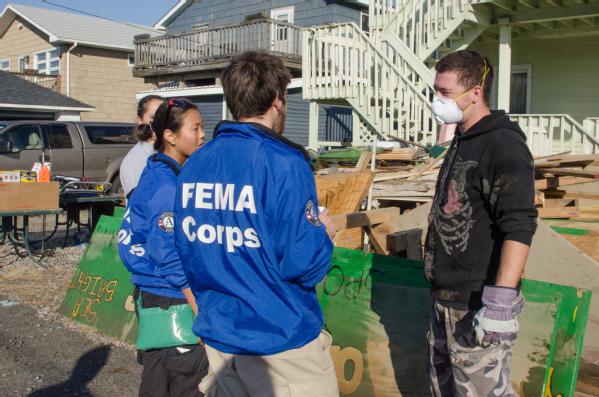 CAPTION: Sea Bright, N.J., Nov. 11, 2012 -- FEMA Corps team members Amy Butterfield and Sergio Tundo talked with volunteer Jason Young to ensure the owner of the residence was getting the needed assistance after Hurricane Sandy destroyed much of the island.
CAPTION: Sea Bright, N.J., Nov. 11, 2012 -- FEMA Corps team members Amy Butterfield and Sergio Tundo talked with volunteer Jason Young to ensure the owner of the residence was getting the needed assistance after Hurricane Sandy destroyed much of the island.
In addition, our 33 currently open
Disaster Recovery Centers are located at convenient public locations in each county. At these Centers you can get help registering for assistance and get answers to questions – nearly 25,000 have already visited. The
U.S. Small Business Administration (SBA) Customer Service Representatives are there as well, receiving applications for low-interest disaster loans. SBA Business Recovery Centers are also open at 10 locations throughout New Jersey to assist eligible business owners in applying for disaster business loans for their physical damage loss and disaster-related working capital needs. Under SBA’s disaster assistance program, low-interest loans are available to homeowners, renters and businesses of all sizes. To date, the SBA has approved 321 disaster home and business loans totaling more than $21 million.
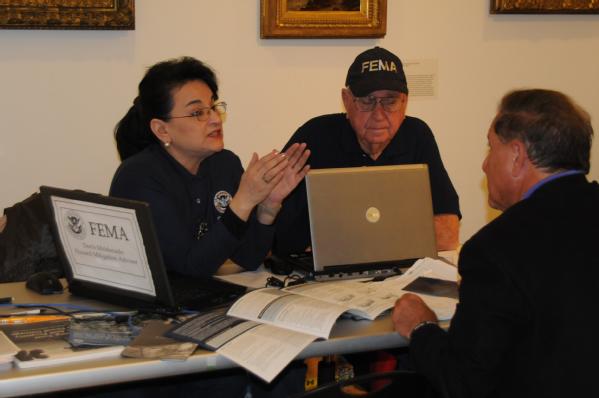 CAPTION: Jersey City, N.J., Nov. 21, 2012 -- At the Hudson County FEMA Disaster Recovery Center at the Jersey City Museum, a Hurricane Sandy survivor receives information from FEMA Mitigation Specialists Doris Maldonado and Tony Hathcock.
CAPTION: Jersey City, N.J., Nov. 21, 2012 -- At the Hudson County FEMA Disaster Recovery Center at the Jersey City Museum, a Hurricane Sandy survivor receives information from FEMA Mitigation Specialists Doris Maldonado and Tony Hathcock.
At the same time, our Public Assistance division is meeting with local government officials all over the state to receive their requests for money to cover their disaster costs. That can include things from overtime costs all the way to the replacement of public buildings destroyed by the hurricane.
We’re partnering with the state of New Jersey to anticipate and help meet needs. Moving forward, we have to work together closely as the situation changes and new challenges arise. Not only has FEMA worked with our federal, state, local, and voluntary partners, we’ve also teamed up with the private sector and academia to get Jersey back on its feet after Sandy. Look for our FEMA Mitigation staff at your local home repair stores for advice about rebuilding stronger, safer and smarter.
 CAPTION: West Long Branch, N.J., Nov. 28, 2012 -- Hazard Mitigation Specialists are available at various Home Depot locations to answer questions regarding building techniques that reduce potential for damage from future disasters
CAPTION: West Long Branch, N.J., Nov. 28, 2012 -- Hazard Mitigation Specialists are available at various Home Depot locations to answer questions regarding building techniques that reduce potential for damage from future disasters
To our “Jersey Strong” communities: You have weathered possibly the most devastating storm in your state’s history. Yet the feeling of hope and restoration prevails in New Jersey. You inspire me every day with your spirit of unity and pride, your hours donated to voluntary organizations, your donations to local survivors, and above all, your neighborliness. Thank you for all that you do. I am confident that you will recover, you will restore – and that together we will rebuild your communities stronger than ever.
This story isn’t over. FEMA remains present to address the challenges that remain and to meet the challenges to come, but it will take the whole community to restore New Jersey.
Together we are cleaning up neighborhoods and getting kids back to school. New Jersey’s state and local leaders stand committed to the promise of a recovery for coastal New Jersey.
And I’m standing with you.
Let us look back to remember what has been lost, but not forget what we’ve done together to restore New Jersey. Stay Jersey Strong.
-Mike




